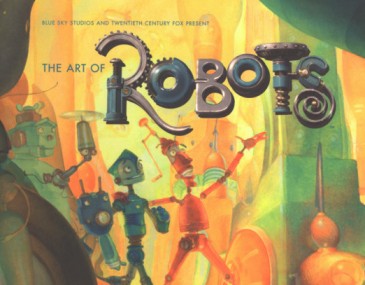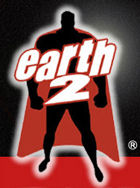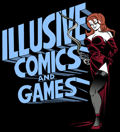Thanks
to Chronicle Books, we can actually take the time to pore
over those little details that may go by too quickly in
the film. The Art of Robots puts a freeze frame on
it, while also carefully deconstructing the art's influences
and development.
Sure,
it's a given that these coffee table books will show up
as tie-ins, but this effort by Amid Amidi (with a preface
by Joyce and foreword by Wedge) does a better job than earlier
efforts from Chronicle at really taking us into the process
of designing an animated film.
Organized
mostly by the film's environments, the book has a decent
sense of flow. Just as in the film, the reader first gets
introduced to Rivet Town and its denizens. If they look
suspiciously like household kitsch items from years gone
by, Amidi proves that's no accident. Whether an inanimate
object or a major character, everything seems to hearken
back to a nostalgic design scheme.
No
sense of the voice-actors exist. Though clearly hero Rodney
Copperbottom resembles Ewan McGregor, it seems accidental.
Amidi would rather show us all the ideas for the character
that failed to make the cut - and the logic that led to
the final design.
One of
the advantages that this book has over previous efforts lies
in a greater access to detail. The layout on some pages draws
clear lines between inspiration and final product, highlighting
specific elements on a character or a building. A few illustrations
also have detailed color "callouts," guides for the animators
that provide another way in to the creative process. Perhaps
such details appeal to only hardcore fans, but they could
certainly spark conversation with your kids.
At
a few points, Amidi even breaks down film sequences. Because
Joyce and Wedge intend everything in Robots to feel
interconnected, the static page actually allows for more
appreciation than the movie does. You
have time to register the nuances of the animators' Rube
Goldberg devices. On
film, the transportation system for the big city comes across
a delirious mess; here, it sort of makes sense.
Though
the layout and pictures have flow, Amidi leaves out a lot
of context. That can be attributed to lack of distance from
the project; this book, after all, exists to hype a movie.
Designers and artists get randomly quoted enthusing over
one element or another, but it's all too fresh to get too
deep.
Only
a few failed ideas get mentioned. Perhaps the most interesting
one is playwright David Lindsey-Abaire's rejected musical
script that seems perfectly in tune with where Joyce and
Wedge ended up going anyway. In a few years, perhaps Chronicle
could devote a book to the "almost was" versions of movies.
In
the end, The Art of Robots makes a satisfying book
to flip through, and stands firmly with Chronicle's growing
library of movie art books. Whether you end up liking the
movie or not is almost beside the point.







